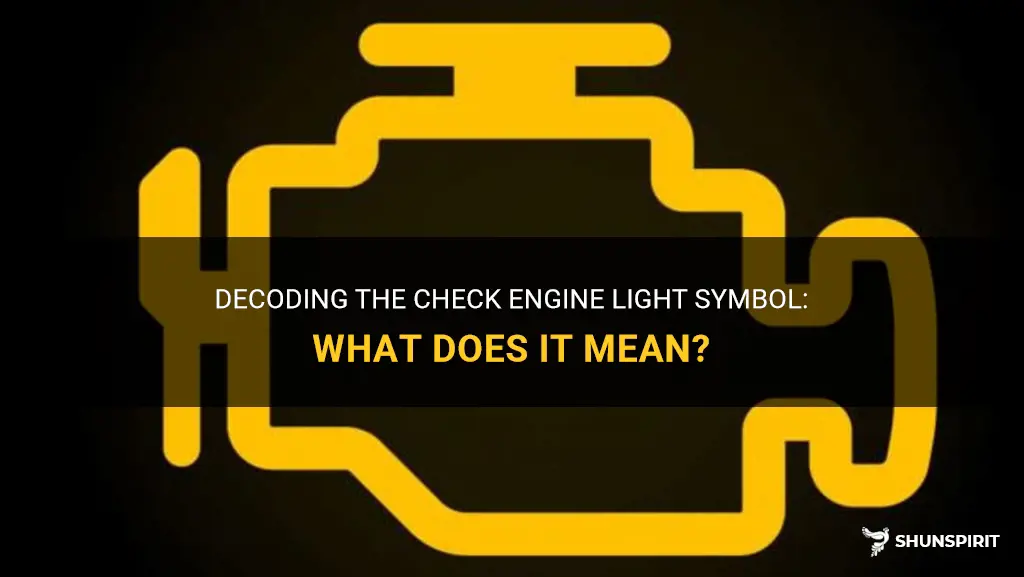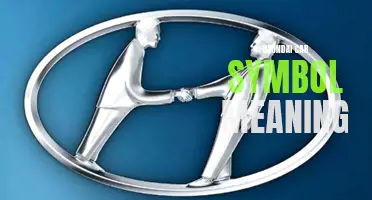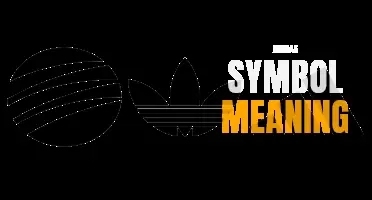
Have you ever been driving along, enjoying your day, only to have your check engine light suddenly illuminate on your dashboard? It's a common occurrence that can cause panic and confusion for many drivers. But what does it really mean when that pesky symbol appears? Join us as we delve into the fascinating world of the check engine light symbol and explore its many meanings. From minor issues to potential disasters, we'll shed light on this iconic dashboard symbol and everything it represents. Buckle up, because we're about to take a deep dive into the check engine light symbol meaning!
What You'll Learn
- What does the check engine light symbol mean on a car dashboard?
- What are the most common reasons for the check engine light to come on?
- Can I still drive my car if the check engine light is on?
- How can I diagnose the cause of a check engine light on my own?
- Are there any temporary fixes or resets I can try before taking my car to a mechanic?

What does the check engine light symbol mean on a car dashboard?
The check engine light is one of the most important warning symbols on a car's dashboard. When this light illuminates, it is indicating that the car's on-board diagnostic (OBD) system has detected a problem with the engine or emissions system. It is not a specific indicator of what the problem is, but rather a general alert to the driver that something is amiss.
When the check engine light comes on, it is important to take it seriously and have the car inspected as soon as possible. Ignoring the light could lead to further damage and potentially expensive repairs down the line. In some cases, driving with the check engine light on may also result in decreased fuel efficiency and increased emissions.
There are many potential reasons why the check engine light may come on. Some of the most common causes include a loose gas cap, a faulty oxygen sensor, a malfunctioning catalytic converter, or a problem with the engine's ignition system. The only way to determine the exact cause of the problem is to have the car's OBD system scanned by a professional mechanic or by using a specialized diagnostic tool yourself.
In some cases, the check engine light may come on and then turn off on its own. This does not mean that the problem has gone away but rather that the OBD system has not detected the issue during subsequent checks. It is still recommended to have the car inspected to ensure there are no underlying problems.
If the check engine light is flashing, it is indicating a more severe problem that requires immediate attention. In such cases, it is important to pull over and have the car towed to a mechanic for further diagnosis and repair.
In conclusion, the check engine light symbol on a car's dashboard is a general warning that something is wrong with the engine or emissions system. It is crucial to have the car inspected as soon as possible to determine the cause of the problem and prevent further damage. Ignoring the check engine light can lead to expensive repairs and potential issues with fuel efficiency and emissions.
Decoding the Mystery: What Does This Symbol Mean in Excel?
You may want to see also

What are the most common reasons for the check engine light to come on?
The check engine light is part of a vehicle's onboard diagnostics system, and it is designed to alert the driver to potential issues with the vehicle's engine or emissions system. When the check engine light comes on, it is important to address the issue as soon as possible to prevent further damage to the vehicle. Here are some of the most common reasons for the check engine light to come on:
- Oxygen sensor malfunction: The oxygen sensors in a vehicle monitor the amount of oxygen in the exhaust gases, helping to ensure the engine is running efficiently. If one or more of the oxygen sensors malfunction, it can cause the check engine light to come on.
- Loose or missing gas cap: A loose or missing gas cap can cause the fuel system to lose pressure, triggering the check engine light. This is one of the most common reasons for the light to come on and is easily fixable by tightening or replacing the gas cap.
- Catalytic converter issues: The catalytic converter is responsible for reducing harmful emissions from the exhaust gases. If it becomes clogged or damaged, it can cause the check engine light to come on. Ignoring catalytic converter issues can lead to decreased fuel efficiency and engine performance.
- Mass airflow sensor problems: The mass airflow sensor measures the amount of air entering the engine and helps determine the correct amount of fuel to inject. If the sensor malfunctions or becomes dirty, it can cause the check engine light to come on. Cleaning or replacing the mass airflow sensor is usually necessary to resolve the issue.
- Spark plug or ignition coil problems: The spark plugs and ignition coils are essential for igniting the fuel-air mixture in the engine. If they become worn out or malfunction, it can cause misfires and trigger the check engine light. Replacing faulty spark plugs or ignition coils can usually resolve the issue.
- EGR system malfunction: The exhaust gas recirculation (EGR) system helps reduce nitrogen oxide emissions by recirculating a portion of the exhaust gases back into the engine. If the EGR valve, sensor, or tubing become clogged or malfunction, it can cause the check engine light to come on.
- Malfunctioning thermostat: The vehicle's thermostat regulates the engine's operating temperature. A malfunctioning thermostat can cause the engine to overheat or not reach operating temperature, triggering the check engine light. Replacing the faulty thermostat can usually resolve the issue.
- Faulty fuel injector: The fuel injectors are responsible for delivering fuel to the engine. If one or more fuel injectors become clogged or malfunction, it can cause the check engine light to come on. Cleaning or replacing the faulty fuel injectors is necessary to fix the problem.
These are just a few of the most common reasons for the check engine light to come on. It is important to have the vehicle diagnosed by a qualified mechanic to determine the exact cause of the issue. Ignoring the check engine light can lead to more significant and costly repairs in the future, so it is always best to address the issue promptly.
Decoding Car AC Symbols: What Do They Really Mean?
You may want to see also

Can I still drive my car if the check engine light is on?
The check engine light is a warning sign that indicates a problem with your car's engine or emission system. Many drivers wonder if they can still drive their car when the check engine light is on. The answer to this question depends on the severity of the issue and the specific circumstances.
In general, it is possible to drive your car when the check engine light is on. However, it is important to note that driving with the check engine light on can be risky, and it is always recommended to address the issue as soon as possible. Ignoring the warning sign and continuing to drive can potentially lead to more serious damage to your car's engine, reduction in fuel efficiency, and increased emissions.
When the check engine light is on, it is advisable to take your car to a qualified mechanic or auto repair shop to have it diagnosed and repaired. A mechanic can use a diagnostic tool to read the error codes stored in your car's computer system and determine the cause of the problem. They will be able to provide you with an accurate diagnosis and recommend the necessary repairs.
In some cases, the issue causing the check engine light to come on may be minor and not affect the performance or safety of your vehicle. However, it is always better to be safe than sorry, and addressing the problem promptly can prevent it from escalating into a more serious and expensive repair.
If your car's check engine light is flashing, it is a sign of a more severe problem that requires immediate attention. A flashing check engine light typically indicates a misfire or a problem with the catalytic converter, which can lead to engine damage if left unaddressed. In this case, it is strongly recommended to pull over, turn off your car, and have it towed to a repair shop to avoid further damage.
In conclusion, while it is sometimes possible to drive your car when the check engine light is on, it is not advisable. Ignoring the warning sign and continuing to drive can lead to more serious damage and costly repairs. It is always recommended to address the issue promptly by taking your car to a qualified mechanic or auto repair shop for diagnosis and repair. Remember, prevention is better than cure, and taking care of your car's maintenance needs can save you time, money, and potential headaches in the long run.
Understanding Weld Symbol Chart: A Guide to Welding Symbols and Their Meanings
You may want to see also

How can I diagnose the cause of a check engine light on my own?
The check engine light, sometimes also known as the malfunction indicator light (MIL), is a warning sign that appears on your car's dashboard. When it lights up, it means that there is an issue with your vehicle's engine or emissions system. While it's always advisable to take your car to a professional mechanic to diagnose and fix the problem, there are a few steps you can take to try and determine the cause of the check engine light on your own.
- Check for loose gas cap: Believe it or not, a loose gas cap is one of the most common causes of a check engine light. Make sure your gas cap is securely tightened. If it's loose, tighten it and see if the light goes away after a few drives.
- Use an OBD-II scanner: An OBD-II (On-Board Diagnostic) scanner is a device that can connect to your car's computer and retrieve diagnostic trouble codes (DTCs). These codes can give you more information about the specific problem causing the check engine light to illuminate. Many auto parts stores offer free code reading services, or you can purchase an OBD-II scanner to use at home.
- Interpret the trouble codes: Once you have the DTCs, you'll need to interpret them. Codes can vary depending on the make and model of your vehicle, so it's best to consult a reliable source for code definitions. You can find code definitions online, in vehicle repair manuals, or on dedicated automotive forums. The codes will give you a starting point for further diagnosis.
- Research common issues: Take advantage of online resources to research common issues related to your vehicle's make and model. Forums, technical websites, and online communities can provide valuable insights from other car owners who have experienced similar problems.
- Inspect your vehicle: Depending on the code and symptoms, you may be able to visually inspect certain components of your vehicle. This could include checking for disconnected or damaged hoses, loose electrical connections, or obvious signs of wear and tear. However, keep in mind that some issues may require more advanced diagnostic equipment or the help of a professional.
- Clear the codes and test drive: If you have successfully diagnosed and fixed the issue, you can use your OBD-II scanner to clear the trouble codes. After clearing the codes, take your car for a test drive to ensure the check engine light does not come back on. If it does, you may need to further investigate or seek professional help.
Remember, diagnosing the cause of a check engine light on your own can be challenging, especially if you're not familiar with automotive systems. It's always recommended to consult a professional mechanic if you're unsure or if the problem persists. Ignoring the check engine light could lead to more serious and expensive problems down the line, so it's best to address it as soon as possible.
Decoding the Symbols of Zara: Unraveling the Hidden Meanings
You may want to see also

Are there any temporary fixes or resets I can try before taking my car to a mechanic?
If your car is experiencing issues or acting up, it can be frustrating and concerning. Before taking your car to a mechanic, there are a few temporary fixes or resets you can try to potentially resolve the issue or at least identify the problem more accurately. These simple troubleshooting steps can save you time and money and get your car back on the road faster.
- Check the basics: Before diving into any complicated fixes, make sure to check the basics first. Begin by inspecting your car for any loose or disconnected wires. Check the battery terminals to ensure they are tightly connected. Verify that all fluids, such as oil and coolant, are at the appropriate levels.
- Reset the computer: Many modern cars have a computerized system that controls various aspects of the vehicle's performance. Sometimes, the system can encounter glitches or errors that can cause issues. To reset the computer, disconnect the negative battery terminal (black cable) for about 15 minutes. This will allow the system to reset and potentially resolve any minor issues.
- Clear error codes: If your car's check engine light is on, there may be an error code stored in the computer system. You can purchase an OBD-II scanner tool to read and clear the error codes yourself. By clearing the codes, you can see if the issue was a one-time occurrence or if it reappears, indicating a more significant problem.
- Change the fuel: If you are experiencing performance issues, such as rough idle or hesitation during acceleration, it may be due to bad fuel. Try filling up your car with fresh, high-quality fuel from a reputable gas station. This can sometimes resolve minor issues caused by impurities or low-quality fuel.
- Check the air filter: A dirty or clogged air filter can restrict airflow to the engine, leading to reduced performance and fuel efficiency. It's a simple and inexpensive fix that you can try yourself. Locate the air filter housing, remove the filter, and inspect it. If it appears dirty or clogged, replace it with a new one.
- Tighten the gas cap: If your check engine light is on and the error code indicates a loose gas cap, try tightening it securely. A loose or improperly sealed gas cap can cause a vacuum leak and trigger the check engine light. Tightening the gas cap may resolve the issue, but if the light persists, further diagnosis may be necessary.
It's important to note that these temporary fixes and resets are not guaranteed solutions and may not resolve all car issues. If your car continues to have problems, it's recommended to take it to a qualified mechanic for a proper diagnosis and repair. They have the expertise and equipment to accurately identify and fix the underlying issues. Ignoring or neglecting the problem can lead to more significant and costly damages down the line.
In conclusion, before taking your car to a mechanic, there are a few temporary fixes or resets you can try. These include checking the basics, resetting the computer, clearing error codes, changing the fuel, checking the air filter, and tightening the gas cap. However, if the issues persist, it's advisable to seek professional help to avoid further complications.
The Hidden Meaning Behind the Mysterious 4 Triangle Symbol
You may want to see also
Frequently asked questions
The check engine light symbol, also known as the malfunction indicator lamp (MIL), is an amber or yellow light that appears on your dashboard to alert you to potential issues with your vehicle's engine. It is a generic warning sign that something is wrong and needs attention.
There are numerous reasons why the check engine light may come on. Some of the most common causes include a loose gas cap, a faulty oxygen sensor, a malfunctioning catalytic converter, a misfiring engine, or a problem with the ignition system. It is important to have the vehicle diagnosed by a professional to determine the exact cause.
While it is possible to continue driving with the check engine light on, it is generally not recommended. The light signifies that there is a problem with your vehicle's engine, and ignoring it can lead to further damage or a breakdown. It is best to have the issue addressed as soon as possible to prevent any potential complications.
Resetting the check engine light may vary depending on the make and model of your vehicle. In some cases, disconnecting the battery for a few minutes can reset the light. However, this method may also reset other important systems in your car. It is recommended to use an OBD-II scanner, which can read and clear the codes associated with the check engine light. If the issue persists after resetting the light, it is advisable to have your vehicle inspected by a qualified mechanic.







